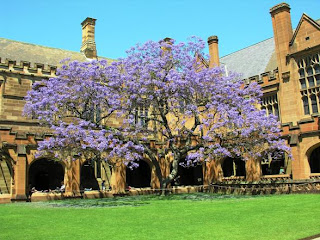
In 1911, 83 students (including 23 women) attended the first classes in Government House, George Street, Brisbane.
The First World War slowed development but afterwards, research and teaching burgeoned as demand for higher education increased. The fledgling University outgrew the buildings in George Street, and the search for a larger campus began.
A site at Victoria Park (now partially occupied by the Mayne Medical School) was secured by statute in 1922 as a possible permanent home for the University. In 1927 Dr James O’Neil Mayne, in association with his sister Miss Mary Emelia Mayne, provided $380,000 to enable the Brisbane City Council to resume 274 acres of land at St Lucia and provide it to the University as its permanent home.

Named after the sugar-producing island of St Lucia in the West Indies, the area originally was used to farm sugar, arrowroot, cotton, maize and pineapples. A sugar mill, washed away by the 1893 flood, operated where the University boat shed now stands.
Lack of finance delayed development of the site, and so the University lent it for a Farm School administered by the State's Department of Agriculture and Stock until construction began in 1937.
The first building, later named the Forgan Smith Building after the Premier of the day, was completed in 1939. The Second World War diverted its use to military purposes and it served first as advanced headquarters for the Allied Land Forces in the South West Pacific. The University's move from George Street to St Lucia was accomplished between 1946 and 1972.

In 1990, the University merged with Queensland Agricultural College (now UQ Gatton) as part of a unified national system abolishing the binary system of universities and colleges of advanced education. And in 1999, UQ Ipswich opened as one of the first purpose-built, completely Web-enabled campuses in Australia.
The University of Queensland (UQ) is one of Australia's premier learning and research institutions. It is the oldest university in Queensland and has produced generations of graduates who have gone on to become leaders in all areas of society and industry. The University is a founding member of the national Group of Eight, an alliance of research-strong "sandstone" universities committed to ensuring that Australia has higher education institutions which are genuinely world class. It belongs also to the global Universitas 21 alliance. This group aims to enhance the quality of university outcomes through international benchmarking and a joint venture e-learning project with The Thomson Corporation.

Faculty of Arts (ARTS)
School of English, Media Studies & Art History (EMSAH)
School of History, Philosophy, Religion & Classics (HPRC)
School of Languages & Comparative Cultural Studies (SLCCS)
School of Music
Faculty of Science (Science)
School of Biomedical Sciences (SBMS)
Department of Anatomy & Developmental Biology
Department of Physiology & Pharmacology
School of Biology (SIB)
Department of Botany
Department of Zoology and Entomology
School of Chemistry and Molecular Sciences (SCMS)
Department of Biochemistry and Molecular Biology
Department of Chemistry
Department of Microbiology & Parasitology
School of Mathematics and Physics
Department of Mathematics
Department of Physics
School of Geography, Planning and Environmental Management (GPEM)
School of Earth Sciences
Faculty of Business, Economics & Law (BEL)
School of Economics
School of Tourism
TC Beirne School of Law
UQ Business School
The Faculty of Engineering, Architecture and Information Technology (EAIT)
School of Engineering (SOE)
Division of Chemical Engineering
Division of Civil Engineering
Division of Environmental Engineering
Division of Materials
Division of Mechanical Engineering
Division of Mechanical and Aeropace Engineering
Division of Mining and Minerals Process Engineering
Division of Mechatronic Engineering
School of Architecture
School of Information Technology and Electrical Engineering (ITEE)
Department of Electrical Engineering (EE)
Department of Systems Engineering
Department of Biomedical Engineering
Department of Computer Science
Faculty of Health Sciences (HEALTH)
School of Health & Rehabilitation Sciences (SHRS)
School of Human Movement Studies
School of Dentistry
School of Medicine (SoM)
School of Nursing and Midwifery
School of Pharmacy
School of Population Health
Faculty of Natural Resources, Agriculture & Veterinary Science (NRAVS)
School of Animal Studies
School of Land, Crop and Food Sciences (LCAFS)
School of Natural & Rural Systems Management (NRSM)
School of Veterinary Science
Faculty of Social & Behavioural Sciences (SBS)
School of Education
School of Journalism & Communication
School of Political Science & International Studies (POLSIS)
School of Psychology
School of Social Science
School of Social Work & Applied Human Sciences
UQ continues to attract the vast majority of the state's highest academic achievers and is renowned nationally and internationally for the quality of its teaching and research. In 1998-99 it was named Australia's University of the Year and it continues to enjoy the highest overall rating for Queensland universities in the annual Good Universities Guide.
UQ remains the most successful Australian university in winning and being shortlisted for Australian Awards for University Teaching since they were established in 1997. On a variety of measures it is one of the top three or four research universities in the country and this success was underlined last year when it celebrated its 5000th PhD graduation. UQ also is building a cluster of international-quality research centres and institutes that will keep it at the frontiers of emerging research fields, particularly the biosciences.
The University of Queensland's graduates have a strong record of success in attaining employment and income levels well above average. UQ qualifications are highly regarded by employers everywhere and our graduates form a powerful network of success across all industries and endeavours in all corners of the globe. In recent years, the international standing of UQ has been reinforced with a rapid growth in fee-paying students from abroad, as well as strong growth in postgraduate studies.


University of Queensland Ranked 33rd in 2007 Thes-QS World University Ranking
University of Queensland Ranked 41st in 2009 Thes-QS World University Ranking
University of Queensland Ranked 43rd in 2010 Thes-QS World University Ranking



















